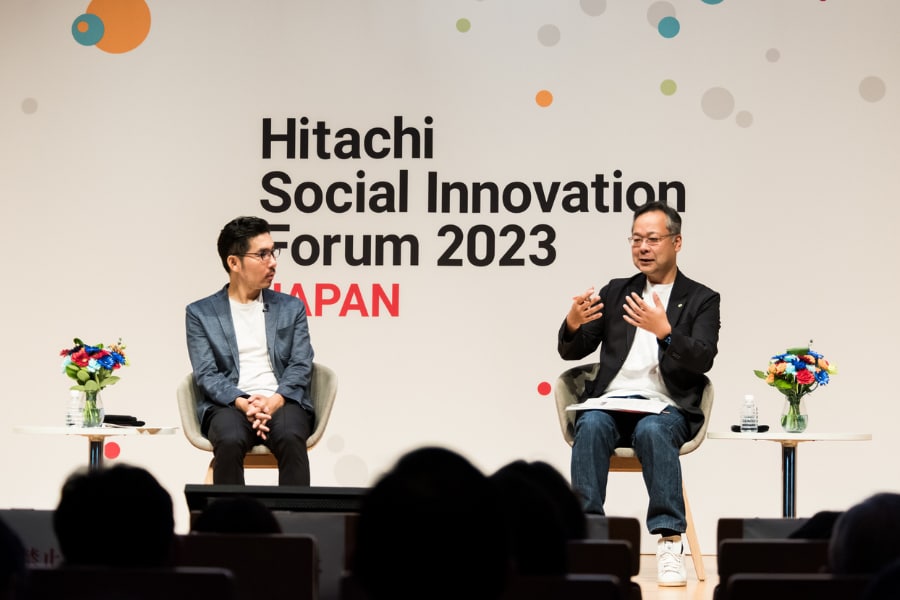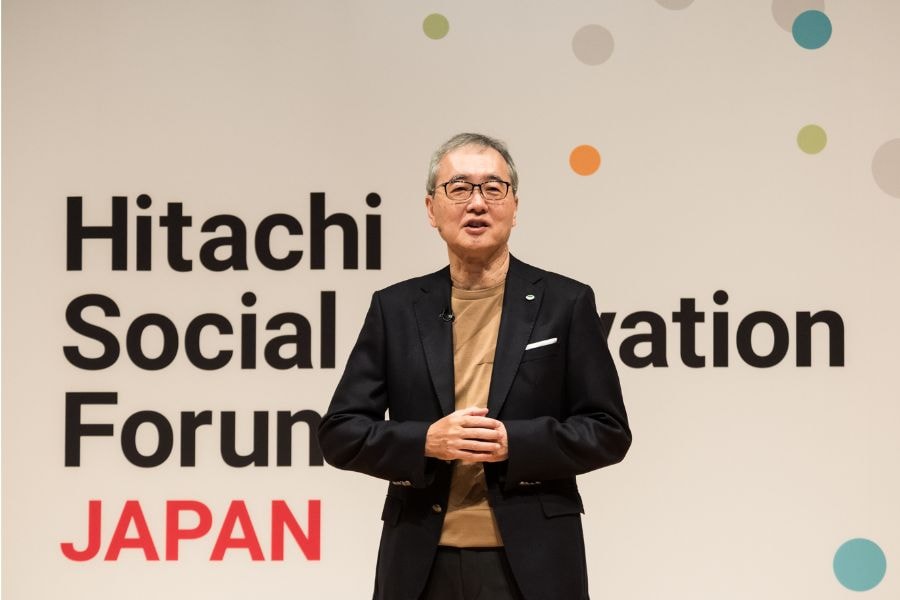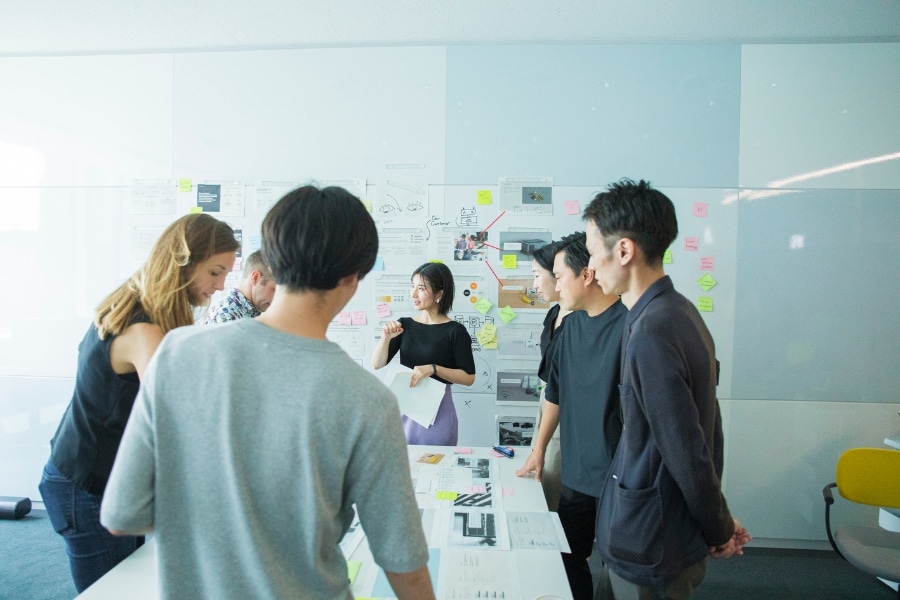Is There a Formula for DX Success? CEOs of Hitachi Digital and PIVOT in Dialogue
Jan. 29, 2024
Mina Shimizu

“Hitachi Social Innovation Forum (HSIF) 2023 Japan” was held on September 20–21. During an interactive session on the first day, Jun Taniguchi, CEO of Hitachi Digital, which leads Hitachi's digital strategy, discussed with Mr. Norihiko Sasaki, CEO of PIVOT, a business video media company.
The topic was “What Should Companies Do to Keep Evolving: Through the Practice of Digital Transformation in Global.” The two CEOs discussed the key points of digital transformation (DX) based on the Hitachi case.
Background of the decline in Japan’s competitiveness
At the beginning of the session, they first looked back on the changes of Japan's global competitiveness. The "World Competitiveness Ranking" published by the International Institute for Management Development (IMD) confirmed that Japan's competitiveness has been on a steady decline for the past 30 years.

Mr. Sasaki pointed out that Japan's competitiveness declined significantly in the late 1990s with the rise of internet companies, such as Google. He asked Taniguchi for his opinion on the background of this decline.
“I was a university student in the early 1990s when Japan was in first place,” said Taniguchi, analyzing Japan's strength as “being able to steadily progress when goals are clearly defined.” He added, “The inability to act swiftly during era of rapid change brought about by the wave of digitalization may led to a decline in our competitiveness.”

In Silicon Valley in the U.S., where Hitachi Digital is based, Taniguchi revealed that, “When we make proposals for business support to clients, even proposals in areas that we have no experience with are often received positively if we demonstrate our capabilities.”
On the other hand, he mentioned that “Japanese companies tend to emphasize their experience" and suggested that “The difference in the way new initiatives is promoted may lead to a gap in the realization of DX.”
Fusion of social infrastructure and digitalization

Mr. Sasaki was interested in the reputation of Hitachi in the epicenter of DX: “How is Hitachi, known for its image of reform in Japan, perceived in Silicon Valley?” Taniguchi replied: “People say we are in a ‘unique position’. While we are involved in the social infrastructure business, our focus on digital technology is garnering attention.” As Hitachi's strengths, Taniguchi cited DX based on products, which are the devices that support infrastructure, and operational technology (OT), which operates them, as Hitachi's strengths.
Offensive DX and defensive DX
Mr. Sasaki continued to ask questions: “What is the key to moving forward with innovation and DX?” In response, Taniguchi introduced two aspects: offensive DX, which focuses on creation of new value, and defensive DX, which improves and streamlines business operations.
As an example of offensive DX, Taniguchi cited the Hitachi Group's GlobalLogic company and its initiatives with a North American power company. Although power generation and electricity sales are very robust business model, new challenges are emerging due to increased environmental awareness and the creation of new regulations. To address these new challenges, it is necessary to create new value. GlobalLogic reaffirmed the power company's vision and purpose with customer's executives. They not only revised the problem-solving and decision-making processes, but also extended its support to talent development methods.
Furthermore, they set out to create new services: wind and solar power management that leverages AI, power grid maintenance that utilizes digitalization, and services that enable electricity users to select the electricity they use by "visualizing" whether it is sourced from renewable energy or not. Therefore, the power company transformed into an energy service provider.
In terms of defensive DX, Taniguchi cited examples of cloud operations as a platform for data, and described solutions to help optimize and automate operations. Use of digital data by companies is expanding rapidly, and this has resulted in a complex mix of development, operations, and other teams, along with a decentralization of resources within companies. Furthermore, cloud technologies are evolving rapidly, and it is difficult to incorporate the latest technologies in business operations. Some companies are constantly struggling with the cost of adopting the latest technologies.
Therefore, Hitachi supports visualization of how cloud computing is being used and the operational status. By looking at the visualized status and leveraging AI for automated predictions, it becomes possible to effectively manage and respond to the identified issues.

Moreover, to make significant strides with DX, it is essential to acquire and train digital talents. Thus, Hitachi has built a network of industrial and technical universities not only in Japan but also overseas and is focusing on educational programs.
Taniguchi comments: “Each region has its own specialty, such as South America for user interface (UI) and user experience (UX) development and Eastern Europe for embedded systems development.” Taniguchi also travels to Poland, Romania, Uruguay, and other countries to strengthen ties and find talent.
“Hitachi will contribute to society by using the power of digitalization.”
At the end of the session, a demonstration using generative AI was presented. When a summary of the conversation generated by ChatGPT was projected on the screen, Taniguchi looked impressed, saying, “It summarized the keywords perfectly.”
“Since the advent of ChatGPT, the evolution of generative AI has been remarkable. Before, it could not summarize very well, but in just one year, its accuracy has improved, and it will continue to evolve at an astonishing speed in the future,” predicted Taniguchi.
An avatar created by generative AI called “Digital Taniguchi” also appeared on the screen. Digital Taniguchi said in a voice reproduced by the generative AI, " I want to contribute to the future of humanity by combining the power of digitalization and all the experience." These words explain the true meaning of a message of “Digital for all.” by Hitachi's digital business.

Upon seeing Taniguchi’s digital alter ego speaking naturally, Mr. Sasaki said: "Since I'm also busy with program recordings, I would love to have a 'Digital Sasaki' created as well." eliciting laughter from the audience.




